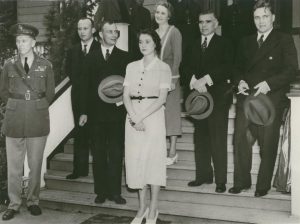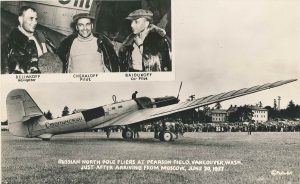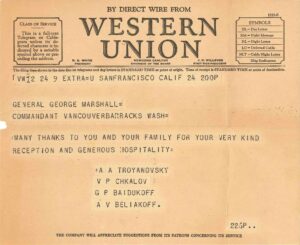 June 20, 1937, may have been the most memorable Sunday morning that George C. Marshall experienced as commander of Vancouver Barracks, Washington. Three days earlier pilot Valeri P. Chkalov, co-pilot Georgi P. Baidukov, and navigator Alexander V. Beliakov departed from Moscow to attempt the first nonstop flight over the North Pole to the United States. Their original destination was Oakland, California, but inclement weather and poor visibility caused the Soviet aviators to make an emergency landing at Pearson Field, Vancouver Barracks. The Soviet aviators successfully completed the first trans-polar flight in history having traveled 5,288 miles in 63 hours.
June 20, 1937, may have been the most memorable Sunday morning that George C. Marshall experienced as commander of Vancouver Barracks, Washington. Three days earlier pilot Valeri P. Chkalov, co-pilot Georgi P. Baidukov, and navigator Alexander V. Beliakov departed from Moscow to attempt the first nonstop flight over the North Pole to the United States. Their original destination was Oakland, California, but inclement weather and poor visibility caused the Soviet aviators to make an emergency landing at Pearson Field, Vancouver Barracks. The Soviet aviators successfully completed the first trans-polar flight in history having traveled 5,288 miles in 63 hours.
As the commanding officer of Vancouver Barracks, George C. Marshall was called upon to host the Soviet aviators. They were brought from Pearson Field to the Marshall’s house where they were able to bathe, eat breakfast, and sleep. Marshall’s accounts of the event, which appear in several letters published in Volume 1 of The Papers of George Catlett Marshall, suggest that hosting the Soviet aviators “was no trouble at all” and that the most difficult aspect to manage was the large number of press and radio officials who descended on the house.
In one letter Marshall noted the only challenge in hosting the Soviet aviators was “getting them complete civilian outfits, altered and all, on a Sunday afternoon.” Marshall continued by describing how this issue was resolved by transforming a large bedroom into “a complete clothing store, with outfits, in such quantities and sizes that anyone could be satisfied.”
 The more than 60 members of the press and radio who arrived at the Marshall’s house to cover the story presented much greater problems for the Marshalls. The rainy weather left the Marshalls with no choice but to invite the media officials into their home, which despite its large size, became rather crowded. Marshall wrote in one account that “three different broadcast setups were established in the house that evening.” While most of the press and radio officials acted professionally Marshall noted that “The photographers were the ones that gave me gray hairs. In the interest of possible scoops, they of course tried to pull any stunt—trying to slip upstairs and photograph the fliers in bed etc., etc., and scrambling all over the plane the moment we relaxed.” The reporters arrived early Sunday morning and stayed at the Marshall’s home until almost midnight during which time Marshall’s wife Katherine “had to feed the news men coffee and sandwiches by the gallon and bale.”
The more than 60 members of the press and radio who arrived at the Marshall’s house to cover the story presented much greater problems for the Marshalls. The rainy weather left the Marshalls with no choice but to invite the media officials into their home, which despite its large size, became rather crowded. Marshall wrote in one account that “three different broadcast setups were established in the house that evening.” While most of the press and radio officials acted professionally Marshall noted that “The photographers were the ones that gave me gray hairs. In the interest of possible scoops, they of course tried to pull any stunt—trying to slip upstairs and photograph the fliers in bed etc., etc., and scrambling all over the plane the moment we relaxed.” The reporters arrived early Sunday morning and stayed at the Marshall’s home until almost midnight during which time Marshall’s wife Katherine “had to feed the news men coffee and sandwiches by the gallon and bale.”
 Soviet Ambassador Alexander A. Troyanovsky, who traveled to Vancouver Barracks to greet the Soviet aviators, was also invited to stay at the Marshall’s house as a guest. As word of the plane’s landing spread, Marshall began to receive telephone calls from Moscow, London, and he was constantly taking phone calls from all over the U.S. and Europe for the rest of the day.
Soviet Ambassador Alexander A. Troyanovsky, who traveled to Vancouver Barracks to greet the Soviet aviators, was also invited to stay at the Marshall’s house as a guest. As word of the plane’s landing spread, Marshall began to receive telephone calls from Moscow, London, and he was constantly taking phone calls from all over the U.S. and Europe for the rest of the day.
The following day Marshall arranged for a parade in honor of the Soviet aviators at Vancouver Barracks, and also accompanied them, along with Ambassador Troyanovsky, and Governor Charles H. Martin of Oregon in a parade through Portland and a Chamber of Commerce luncheon. After the Soviet aviators departed for the east coast, George, Katherine, and Molly traveled to Tillamook, Oregon, where they spent several days taking a much-deserved rest.
